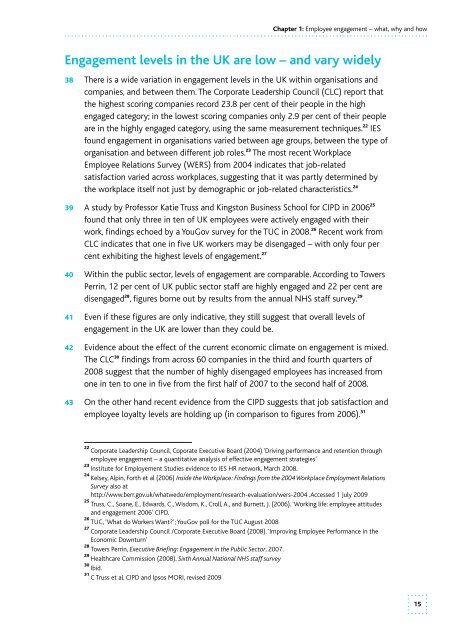3ytgeaf
3ytgeaf
3ytgeaf
Create successful ePaper yourself
Turn your PDF publications into a flip-book with our unique Google optimized e-Paper software.
Chapter 1: Employee engagement – what, why and how<br />
Engagement levels in the UK are low – and vary widely<br />
38 There is a wide variation in engagement levels in the UK within organisations and<br />
companies, and between them. The Corporate Leadership Council (CLC) report that<br />
the highest scoring companies record 23.8 per cent of their people in the high<br />
engaged category; in the lowest scoring companies only 2.9 per cent of their people<br />
are in the highly engaged category, using the same measurement techniques. 22 IES<br />
found engagement in organisations varied between age groups, between the type of<br />
organisation and between different job roles. 23 The most recent Workplace<br />
Employee Relations Survey (WERS) from 2004 indicates that job-related<br />
satisfaction varied across workplaces, suggesting that it was partly determined by<br />
the workplace itself not just by demographic or job-related characteristics. 24<br />
39 A study by Professor Katie Truss and Kingston Business School for CIPD in 2006 25<br />
found that only three in ten of UK employees were actively engaged with their<br />
work, findings echoed by a YouGov survey for the TUC in 2008. 26 Recent work from<br />
CLC indicates that one in five UK workers may be disengaged – with only four per<br />
cent exhibiting the highest levels of engagement. 27<br />
40 Within the public sector, levels of engagement are comparable. According to Towers<br />
Perrin, 12 per cent of UK public sector staff are highly engaged and 22 per cent are<br />
disengaged 28 , figures borne out by results from the annual NHS staff survey. 29<br />
41 Even if these figures are only indicative, they still suggest that overall levels of<br />
engagement in the UK are lower than they could be.<br />
42 Evidence about the effect of the current economic climate on engagement is mixed.<br />
The CLC 30 findings from across 60 companies in the third and fourth quarters of<br />
2008 suggest that the number of highly disengaged employees has increased from<br />
one in ten to one in five from the first half of 2007 to the second half of 2008.<br />
43 On the other hand recent evidence from the CIPD suggests that job satisfaction and<br />
employee loyalty levels are holding up (in comparison to figures from 2006). 31<br />
22<br />
Corporate Leadership Council, Coporate Executive Board (2004) ‘Driving performance and retention through<br />
employee engagement – a quantitative analysis of effective engagement strategies’<br />
23<br />
Institute for Employement Studies evidence to IES HR network, March 2008.<br />
24<br />
Kelsey, Alpin, Forth et al (2006) Inside the Workplace: Findings from the 2004 Workplace Employment Relations<br />
Survey also at<br />
http://www.berr.gov.uk/whatwedo/employment/research-evaluation/wers-2004 .Accessed 1 July 2009<br />
25<br />
Truss, C., Soane, E., Edwards, C., Wisdom, K., Croll, A., and Burnett, J. (2006). ‘Working life: employee attitudes<br />
and engagement 2006’ CIPD.<br />
26<br />
TUC, ‘What do Workers Want’; YouGov poll for the TUC August 2008<br />
27<br />
Corporate Leadership Council /Corporate Executive Board (2008). ‘Improving Employee Performance in the<br />
Economic Downturn’<br />
28<br />
Towers Perrin, Executive Briefing: Engagement in the Public Sector, 2007.<br />
29<br />
Healthcare Commission (2008). Sixth Annual National NHS staff survey<br />
30<br />
Ibid.<br />
31<br />
C Truss et al, CIPD and Ipsos MORI, revised 2009<br />
15


